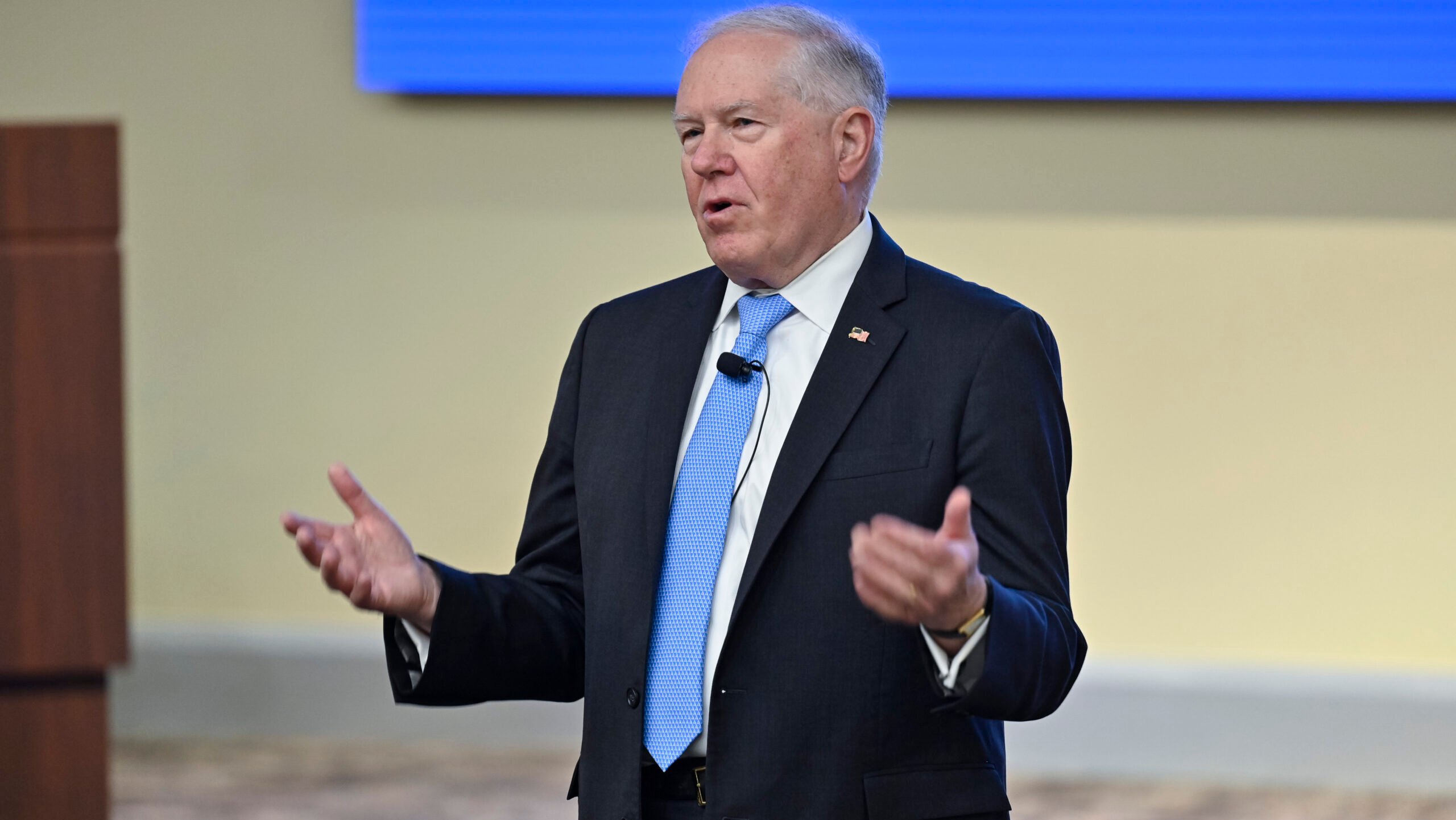
Secretary of the Air Force Frank Kendall speaks with students and guests during the Senior Leader Orientation Course at Joint Base Andrews, Md., July 24, 2023. (U.S. Air Force photo by Eric Dietrich)
WASHINGTON — On the heels of lawmakers’ approval for his “quick start” initiative, Air Force Secretary Frank Kendall is putting the new authority to work on two programs.
During a hearing of the Senate Armed Services Committee today, Kendall told lawmakers he has selected two projects to kick off work — one on “resilient” GPS capabilities and another on battle management for moving target indication (MTI) — which are led by the Space Force and Air Force respectively, an Air Force press release says.
“We selected these projects because we recognized their potential to benefit the Joint Forces and the nation and we’re appreciative that the Secretary of Defense and Deputy Secretary of Defense expedited their review and approval—resulting in less than four months between enactment of the authority to execution of the first projects,” Kendall said in the release.
Approved by Congress as part of the fiscal year 2024 National Defense Authorization Act, the quick start initiative was Kendall’s brainchild to speed up acquisitions by getting around constraints of the cumbersome budget process. The effort is aimed at accelerating nascent program activities, as the authority only enables the military services to proceed with early engineering and design activities for a given project.
Floated as a $300 million pot, Congress ended up granting only $100 million in authority for the initiative, which must be shared by all the military services and approved individually by the Secretary of Defense. The money is only an authority, meaning that the funds themselves have to be provided by the services.
The two projects picked for approval are now able to move forward on early design activities, which will lay the groundwork for both to become programs of record in the FY26 budget, according to the Air Force press release. Both also address Kendall’s “operational imperatives” and fill key capability gaps for the joint force.
For example, the wars in Gaza and Ukraine have underscored the need for systems that can withstand or have an alternative to intense GPS interference, an issue that has spilled over into commercial services like air travel and shipping. The Pentagon has been moving to harden GPS capabilities through new M-code receivers and modernized satellites, but the effort has been delayed over getting a long-troubled ground system working.
It’s not exactly clear what new efforts could be yielded by Kendall’s reference to resilient GPS, though the Space Force has asked for industry input on launching relatively cheaper demonstration satellites that could bolster GPS capabilities. The Air Force did not immediately respond to a request for more information.
Additionally, yielding new MTI capabilities has been another critical objective of the Department of the Air Force (DAF), which will leverage both air- and space-based assets to track objects on the ground and in the air. Seeking to shift many of those capabilities to space, the DAF has moved to rapidly retire an aging JSTARS fleet and is working with the National Reconnaissance Office to field a new space-based sensor that can track targets on the ground.
According to Kendall, the program to get a quick start blessing would specifically focus on command, control and communications battle management, or C3BM, for MTI. The Air Force has said its C3BM “enterprise” will essentially be composed of programs that all seamlessly integrate together to contribute to the Pentagon’s larger Joint All Domain Command and Control (JADC2) project. Kendall’s reference to C3BM for MTI would appear to be aimed at fitting those new MTI capabilities into the larger JADC2 architecture.
Separately, the Air Force has moved to swiftly field the E-7A Wedgetail radar plane, which will replace the service’s elderly E-3 Sentry and provide MTI capabilities. But Kendall revealed today that effort has been delayed, with production of one aircraft slipping “a year to the right.”
When the Air Force awarded Boeing a sole-source award for the Wedgetail last year, the service indicated it wanted to field the first of two rapid prototypes by FY27. After publication of this article, an Air Force spokesperson clarified that the two rapid prototypes are “on schedule” to deliver by the fourth quarter of FY27, but that a price disagreement between Boeing and the Air Force hampered plans to order one production aircraft in FY25.
To allow more time for negotiations to finish, the Air Force now plans to order that aircraft in FY26, which would kick off the program’s production phase. According to the Air Force spokesperson, “production aircraft will field four years after being ordered.”
The two parties have made progress on the price snag, Kendall said today, but have not yet reached an agreement.
“We have come much closer, but we’re not really at closure yet. So we have some additional work to do there,” he said. “So I’m anticipating, maybe being optimistic here, but hopefully that we’ll get to an agreement very shortly and then be able to move on to the program.”
UPDATED 4/1624 at 2:05 PM ET with comment from the Air Force clarifying the E-7A delay.
Australia tops up Ukraine military aid with $100M
Australia has already supplied Ukraine with 120 Bushmaster vehicles, six 155mm howitzers, 56 M113 armored vehicles, 14 special operations vehicles and its signature cardboard drones.



























